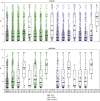MMPred: a tool to predict peptide mimicry events in MHC class II recognition
- PMID: 39722794
- PMCID: PMC11669352
- DOI: 10.3389/fgene.2024.1500684
MMPred: a tool to predict peptide mimicry events in MHC class II recognition
Abstract
We present MMPred, a software tool that integrates epitope prediction and sequence alignment algorithms to streamline the computational analysis of molecular mimicry events in autoimmune diseases. Starting with two protein or peptide sets (e.g., from human and SARS-CoV-2), MMPred facilitates the generation, investigation, and testing of mimicry hypotheses by providing epitope predictions specifically for MHC class II alleles, which are frequently implicated in autoimmunity. However, the tool is easily extendable to MHC class I predictions by incorporating pre-trained models from CNN-PepPred and NetMHCpan. To evaluate MMPred's ability to produce biologically meaningful insights, we conducted a comprehensive assessment involving i) predicting associations between known HLA class II human autoepitopes and microbial-peptide mimicry, ii) interpreting these predictions within a systems biology framework to identify potential functional links between the predicted autoantigens and pathophysiological pathways related to autoimmune diseases, and iii) analyzing illustrative cases in the context of SARS-CoV-2 infection and autoimmunity. MMPred code and user guide are made freely available at https://github.com/ComputBiol-IBB/MMPRED.
Keywords: MHC class II; SARS-CoV-2; autoimmune disease; epitope prediction; molecular mimicry; sequence alignment.
Copyright © 2024 Guerri, Junet, Farrés and Daura.
Conflict of interest statement
Authors FG, VJ and JF are employed by Anaxomics Biotech, Barcelona, Spain. The author declares that the research was conducted in the absence of any commercial or financial relationships that could be construed as a potential conflict of interest.
Figures




Similar articles
-
CNN-PepPred: an open-source tool to create convolutional NN models for the discovery of patterns in peptide sets-application to peptide-MHC class II binding prediction.Bioinformatics. 2021 Dec 7;37(23):4567-4568. doi: 10.1093/bioinformatics/btab687. Bioinformatics. 2021. PMID: 34601583 Free PMC article.
-
MMpred: a distance-assisted multimodal conformation sampling for de novo protein structure prediction.Bioinformatics. 2021 Dec 7;37(23):4350-4356. doi: 10.1093/bioinformatics/btab484. Bioinformatics. 2021. PMID: 34185079
-
NetMHCpan, a method for MHC class I binding prediction beyond humans.Immunogenetics. 2009 Jan;61(1):1-13. doi: 10.1007/s00251-008-0341-z. Epub 2008 Nov 12. Immunogenetics. 2009. PMID: 19002680 Free PMC article.
-
Shared Pathogenicity Features and Sequences between EBV, SARS-CoV-2, and HLA Class I Molecule-binding Motifs with a Potential Role in Autoimmunity.Clin Rev Allergy Immunol. 2023 Aug;65(2):206-230. doi: 10.1007/s12016-023-08962-4. Epub 2023 Jul 28. Clin Rev Allergy Immunol. 2023. PMID: 37505416 Review.
-
Molecular mimicry and autoimmunity in the time of COVID-19.J Autoimmun. 2023 Sep;139:103070. doi: 10.1016/j.jaut.2023.103070. Epub 2023 Jun 12. J Autoimmun. 2023. PMID: 37390745 Free PMC article. Review.
References
-
- Abadi M., Agarwal A., Barham P., Brevdo E., Chen Z., Citro C., et al. (2016). TensorFlow: large-scale machine learning on heterogeneous distributed systems. arXiv, 1603. 10.48550/arXiv.1603.04467 - DOI
LinkOut - more resources
Full Text Sources
Research Materials
Miscellaneous

